| |||||
| Decades: | |||||
|---|---|---|---|---|---|
| See also: | Other events of 1902 List of years in Argentina | ||||
| |||||
| Decades: | |||||
|---|---|---|---|---|---|
| See also: | Other events of 1902 List of years in Argentina | ||||
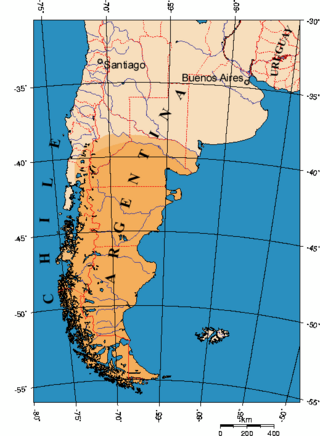
Patagonia is a geographical region that encompasses the southern end of South America, governed by Argentina and Chile. The region comprises the southern section of the Andes Mountains with lakes, fjords, temperate rainforests, and glaciers in the west and deserts, tablelands, and steppes to the east. Patagonia is bounded by the Pacific Ocean on the west, the Atlantic Ocean to the east, and many bodies of water that connect them, such as the Strait of Magellan, the Beagle Channel, and the Drake Passage to the south.

Argentina is divided into twenty-three federated states called provinces and one called the autonomous city of Buenos Aires, which is the federal capital of the republic as decided by the Argentine Congress. The provinces and the capital have their own constitutions and exist under a federal system.

Neuquén is a province of Argentina, located in the west of the country, at the northern end of Patagonia. It borders Mendoza Province to the north, Rio Negro Province to the southeast, and Chile to the west. It also meets La Pampa Province at its northeast corner.
Neuquén is the capital city of the Argentine province of Neuquén and of the Confluencia Department, located in the east of the province. It occupies a strip of land west of the confluence of the Limay and Neuquén rivers which form the Río Negro, making it part of the ecoregion of Alto Valle del Río Negro. The city and surrounding area have a population of more than 340,000, making it the largest city in Patagonia. Along with the cities of Plottier and Cipolletti, it is part of the Neuquén – Plottier – Cipolletti conurbation.

Alejo Julio Argentino Roca Paz was an army general and statesman who served as President of Argentina from 1880 to 1886 and from 1898 to 1904. Roca is the most important representative of the Generation of '80 and is known for directing the Conquest of the Desert, a series of military campaigns against the indigenous peoples of Patagonia sometimes considered a genocide.

Departments form the second level of administrative division, and are subdivided in municipalities. They are extended in all of Argentina except for the Province of Buenos Aires and the Autonomous City of Buenos Aires, the national capital, each of which has different administrative arrangements.
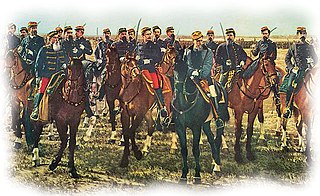
The Conquest of the Desert was an Argentine military campaign directed mainly by General Julio Argentino Roca during the 1870s and 1880s with the intention of establishing dominance over Patagonia, inhabited primarily by indigenous peoples. The Conquest of the Desert extended Argentine territories into Patagonia and ended Chilean expansion in the region.
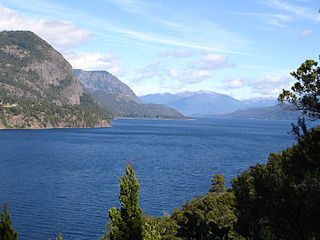
Lácar Lake is a lake of glacial origin in Neuquén Province, Argentina. It is enclosed in the Andes mountain range, at 630 m above mean sea level. The area around the lake is mostly uninhabited, except for the city of San Martín de los Andes on its northeastern coast. The lake has a surface area of 55 km2 (21 sq mi) and a mean depth of 167 m, with a maximum of 277 m. Its catchment basin comprises 1,048 km2 (405 sq mi). Like many Andean Argentine lakes, it drains across Chile and into the Pacific Ocean, in this case via the Huahum River that flows through Huahum Pass in the Andes. As the northernmost lake on the eastern side of Andes that drains to the Pacific the lake and its catchment basin were claimed by Chile until 1902 based on an interpretation of the Boundary treaty of 1881 between Chile and Argentina. The lake, along with the smaller lake nearby, Lolog, has some sacred significance for the Mapuche people, as it features in their oral tradition as part of a creation myth. Large sections of the lake's shores are made of cliffs.
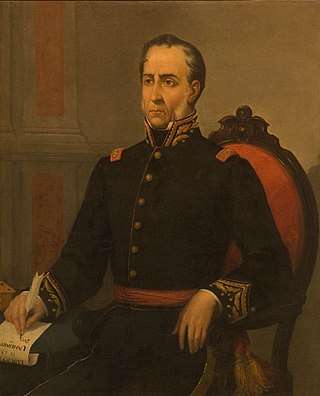
Martín Rodríguez was an Argentine politician and soldier.
The Araucanization of Patagonia was the process of the expansion of Mapuche culture, influence, and its Mapudungun language from Araucanía across the Andes into the plains of Patagonia. Historians disagree over the time period during which the expansion took place, but estimate it occurred roughly between 1550 and 1850.
The Buenos Aires and Pacific Railway (BA&P) was one of the Big Four broad gauge, 1,676 mm, British-owned companies that built and operated railway networks in Argentina.

Nicolás Rodriguez Peña was an Argentine politician. Born in Buenos Aires in April 1775, he worked in commerce which allowed him to amass a considerable fortune. Among his several successful businesses, he had a soap factory partnership with Hipólito Vieytes, which was a center of conspirators during the revolution against Spanish rule. In 1805 he was a member of the "Independence Lodge", a masonic lodge, along with other prominent revolutionary patriots such as Juan José Castelli and Manuel Belgrano. This group used to meet in his ranch, then situated in what today is Rodriguez Peña square in Buenos Aires.
The Pacts of May are four protocols signed in Santiago de Chile by Chile and Argentina on 28 May 1902 in order to extend their relations and resolve its territorial disputes. The disputes had led both countries to increase their military budgets and run an arms race in the 1890s.

The Boundary Treaty of 1881 between Argentina and Chile was signed on 23 July 1881 in Buenos Aires by Bernardo de Irigoyen, for Argentina, and Francisco de Borja Echeverría, for Chile, with the aim of establishing a precise border between the two countries based on the uti possidetis juris principle. Despite dividing largely unexplored lands, the treaty laid the groundwork for nearly all of Chile's and Argentina's 5600 km current border.

Ángel Pacheco, was an Argentine military officer trained by José de San Martín who later became one of the top commanders in the Confederacy during the dictatorship of Juan Manuel de Rosas. He never lost a battle in which he was in command.
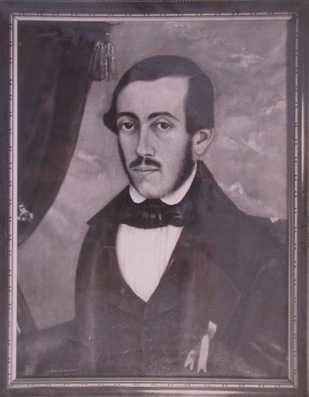
Benjamin Franklin Rawson was an Argentine painter who belonged to the first generation of Argentine painters called the "precursors". His best known works are the Murder of Manuel Vicente Maza and Rescue in the Cordillera.

Estanislao Severo Zeballos was an Argentine lawyer and politician who was Minister of Foreign Affairs of his country three times. He was one of the most prominent intellectuals and politicians of his time. He wrote on a broad range of subjects in books and periodicals, including Catholicism, history, ethnography and geography.

Choiyoi Group is a Permian and Triassic-aged group of volcano-sedimentary formations in Argentina and Chile. The group bears evidence of bimodal-style volcanism related to an ancient subduction zone that existed along the western margin of the supercontinent Gondwana.

Resistencia Ancestral Mapuche is an indigenous organization advocated to the creation of an autonomous Mapuche state in Araucanía, which is, they say, the revindication and recovery of former Mapuche lands. They are mostly renowned for their violent methods, often recurring to arson and poaching and armed attacks against Argentine National Gendarmerie. It operates in the Patagonia region of Argentina and Chile, seeking to secede territories of both countries to create an independent Wallmapuche country for the Mapuche nation. It is associated with the Coordinadora Arauco-Malleco, considered a terrorist organization by the Chilean government.

Rufina Cambaceres was the sole heiress to a large fortune derived from cattle ranching in Argentina. In 1902, at the age of 19, she was found apparently lifeless, and buried in the family vault in Buenos Aires. After her interment, noises were heard from the tomb, and she was subsequently discovered to have been buried alive. Since her premature burial, she is popularly known as "the girl who died twice", and her tomb is one of the most famous in La Recoleta Cemetery.